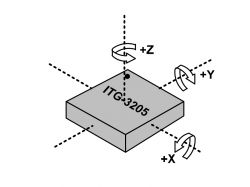UP42 - A Walkera UP02 Quadcopter firmware flasher clone
UP42 is a multi platform (Windows 32/64, Linux 32/64) command line utility with the following features:
- Walkera firmware en-/decryption
- Serial port DTR can be used to force receiver into boot loader mode
- Configurable profiles in simple ‘.ini’ file style config file
- fast
[Read more…]
One of the important parts of a quadcopter controller is a gyro. The RX2635H uses an ITG-3205 from INVENSENSE. Accessing it is very simple as it uses the I2C interface (Two Wire Interface - TWI on the XMEGA) to read the X, Y and Z values of the gyro.
[Read more…]
Now that it’s possible to write custom firmware for a Walkera Hoten-X RX2635H-D receiver it’s time to try to access the various components on the ATMEL XMEGA32A4 based receiver board. First thing was to blink a LED which was quite simple. But for easier development there must first be a more user friendly way interact with the board. Fortunately there is a serial port available. It is normally used to upload new firmware and as additional channel for controlling e.g. a camera in the original Walkera firmware.
[Read more…]
Based on the findings of previous posts I wrote a simple program using ATMEL’s AVR Studio and flashed it onto the Walkera Hoten-X RX2635H receiver. It’s very simple. Its the classic “hello world” program. As the receiver has only one LED to communicate with the outside world I used this LED as user interface. The program uses morse code to send the text “OK” by pulsing the LED. This results in the pulses - - - (long long long) - . - (long short long) for the characters O and K.
[Read more…]
After playing around with analyzing how the firmware update process for a Walkera Hoten-X receiver (RX2635H) works and how this firmware is secured with a simple encryption method it’s now time to analyze the receiver hardware. So that it meight be possible to develop a custom firmware for this receiver.
[Read more…]
